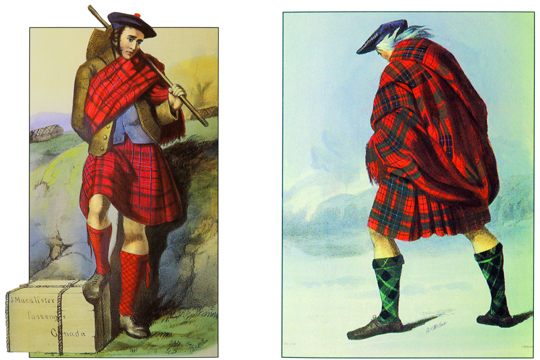

 |
| Folded plaid and unpleated breacan |
Unfolded plaid used as cloak |
|
FREQUENTLY ASKED QUESTIONS ABOUT ORMISTON TARTANS |
| Question : |
What are the origins and history of tartans?
|
|
The ancient Celts wore coats of varied colors with patterns of checks set close
together. Similar patterns have been used in Scottish, Irish, and Welsh weaving
for centuries. A possible predecessor to the modern tartan was found near the
Antonine Wall, between Glasgow and the Firth of Forth. Known as the "Falkirk
sett," it dates from the 3rd century and has a checked pattern in two colors
identified as the undyed brown and white of the native Soay sheep. The fabric had
been used as a stopper in an earthenware pot which contained about 2000 Roman
silver coins.
Multicolored cloth was used by the Celts from the earliest time, but the variety of colors in garments was greater or less, according to the rank of the wearer. Cloth of the ancient kings had seven colors, that of the druids six, and that of the nobles four. In 1700, the tartans were used to distinguish the inhabitants of different districts and not the members of different families as at present. For centuries, the patterns were loosely associated with the weavers of a particular area, though it was common for highlanders to wear a number of different tartans at the same time. From 1725 the government force of the Highland Independent Companies introduced a standardized tartan chosen to avoid association with any particular clan, and this was formalized when they became the Black Watch regiment in 1739. This tartan has been accepted as one of the universal tartans and is currently in use by families not associated with a particular clan or district. In 1745, Bonnie Prince Charlie led the Jacobite revolution to return the Stuart Kings to the thrones of Scotland and England. The most effective fighters for Jacobitism were the supporting Scottish clans, leading to an association of tartans with the Jacobite cause. The defeat of the Jacobite forces at Culloden led to the 1746 Dress Act banning tartans and other forms of Highland dress. Soon after the Act was repealed in 1782 Highland Societies of landowners were promoting "the general use of the ancient Highland dress". By the 19th century the Highland romantic revival inspired by James Macpherson's Ossian poems and the writings of Sir Walter Scott led to wider interest in tartans, with clubs like the Celtic Society of Edinburgh welcoming Lowlanders. The pageantry invented for the 1822 visit of King George IV to Scotland brought a sudden demand for tartan cloth and made it the national dress of the whole of Scotland, with the invention of many new clan tartans to suit. The naming and registration of official clan tartans began on April 8, 1815 when the Highland Society of London (founded 1778) resolved that all the clan chiefs each "... be respectfully solicited to furnish the Society with as Much of the Tartan of his Lordship's Clan as will serve to Show the Pattern and to Authenticate the Same by Attaching Thereunto a Card bearing the Impression of his Lordship's Arms." Many had no idea of what their tartan might be, but were keen to comply and to provide authentic signed and sealed samples. Lord Macdonald was so far removed from his Highland heritage that he wrote the Society: "Being really ignorant of what is exactly The Macdonald Tartan, I request you will have the goodness to exert every Means in your power to Obtain a perfectly genuine Pattern, Such as Will Warrant me in Authenticating it with my Arms." The tartan of a Scottish clan is a sequence of colors and shades unique to the material, authorized by the clan society for use by members of that clan for kilts, ties, and other garments and decorations. Every clan with a society has at least one distinct tartan. Any tartan specified in a Grant of Arms by the Lord Lyon is registered by him, but there is no legal prohibition against wearing the "wrong" tartan. It is considered proper to wear a clan tartan if the wearer is associated with the clan by name, by blood or by legal adoption. It is also proper to wear a tartan ascribed to the district, county, or shire. (Reference source: Wikipedia, the free encyclopedia ) |

|
Return to TARTAN PAGE |
